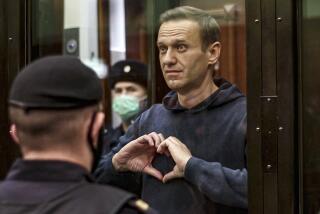Lenin remains powerful symbol of Russian domination of Ukraine

It’s been 22 years since Ukrainians sent the Soviet Communist Party packing and resumed self rule after almost seven decades of Russian domination and enforced incorporation into the Soviet Union.
So why are Ukrainian protesters targeting statues of Vladimir Lenin, the Bolshevik leader whose vision of a communist-ruled superpower has been dead for a generation?
The Kremlin officially lost its grip on Ukraine with Kiev’s 1991 declaration of independence in the months before the Soviet Union dissolved into its 15 constituent republics.
But Moscow’s influence never really waned in post-Soviet Ukraine, where mining of natural resources, agriculture, heavy industries and trade were deeply integrated with the other Soviet republics and directed from Moscow.
In fact, Russia has exerted influence over its neighbor for centuries, vying with Poland and Lithuania for control of Ukraine, which means “at the border.”
Ukraine has hosted the Black Sea Fleet from the time the Kremlin based the Russian navy on the Crimean Peninsula in 1783. During the wars against the Ottoman Empire and the two world wars of the 20th century, the historic intermingling of Russians and Ukrainians intensified as shipyards and other industries were developed to support the Soviet fleet.
Today, more than a quarter of Ukraine’s 46 million citizens are Russian speakers, concentrated in the eastern regions where Soviet-era industries remain dependent on Russia for production materials, energy and export.
That cultural and linguistic divide has sharpened the political conflict over the past three weeks that has largely pitted pro-Russian Ukrainians in the east against the western cities’ residents who want closer economic and political ties with the European Union.
Ukrainian President Viktor Yanukovich and Prime Minister Mykola Azarov, both drawing their political support from the eastern and Russian-speaking areas of Ukraine, have cast the pivot away from Brussels as a pragmatic and possibly temporary decision. Russian President Vladimir Putin, who hopes to corral the ex-Soviet states into a Eurasian Union under his sway, had threatened to cut vital natural gas supplies to Ukrainian industry and Yanukovich likely holds out hope that Moscow will help Ukraine -- at least more than would the European Union -- as it faces an impending due date on $17 billion in foreign debt interest that it cannot pay.
Demonstrators toppled a statue of Lenin in Kiev on Sunday and vandalized another in the southern town of Kotovsk on Monday.
“Statues and monuments from the Soviet era - much more than those from the Russian imperial or even Austro-Hungarian past - are hated symbols for many,” said Robert English, a professor of Russian studies at USC. “The wrongs of the 18th or 19th century are distant.”
Eight million Ukrainians died in the manmade “terror-famine” of the early 1930s, when Soviet dictator Josef Stalin crushed the Ukrainian peasantry during the communist state’s drive to collectivize agriculture, English noted.
Stalin was particularly brutal toward the Ukrainians because of their numbers and the difficulty of bringing the proud and fiercely independent population to heel, English said.
“To many Ukrainians, Lenin represents not only the communist regime, but also radical separation from Europe and Western civilization more broadly,” said Steven Fish, a Russian studies professor at UC Berkeley. “Lenin despised democracy, the market economy, and the Judeo-Christian religious tradition, each of which is central to the modern Western experience.”
Anna Vassilieva, a professor of Russian politics and Crimean culture at the Monterey Institute of International Studies, blames the protesters’ focus on Lenin on rampant nationalism among western Ukrainians and an absence of images of the true target of their wrath: Stalin.
“Everyone knows that the worst was done by Stalin but there are no monuments left to him,” Vassilieva said. “The only Russian thing left to attack is Lenin.”
ALSO:Obama to speak at Nelson Mandela memorial
U.S. to fly African Union troops to Central African Republic
Syrian army reportedly seizes third town along key north-south highway
A foreign correspondent for 25 years, Carol J. Williams traveled to and reported from more than 80 countries in Europe, Asia, the Middle East and Latin America.
More to Read
Start your day right
Sign up for Essential California for news, features and recommendations from the L.A. Times and beyond in your inbox six days a week.
You may occasionally receive promotional content from the Los Angeles Times.







